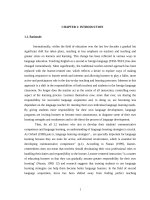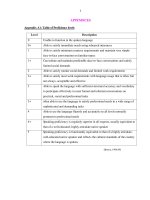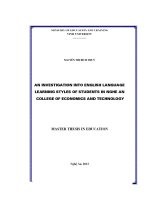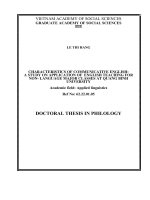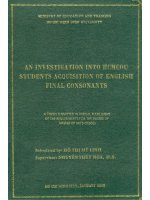AN INVESTIGATION INTO ENGLISH LEARNING STYLES OF NON – LANGUAGE MAJOR FRESHMEN AT QUANG BINH UNIVERSITY tran thi giang nga
Bạn đang xem bản rút gọn của tài liệu. Xem và tải ngay bản đầy đủ của tài liệu tại đây (561.78 KB, 8 trang )
AN INVESTIGATION INTO ENGLISH LEARNING STYLES OF NON –
LANGUAGE MAJOR FRESHMEN AT QUANG BINH UNIVERSITY
Le Thi Hang, Ph.D
Tran Thi GiangNga
University of English Language K54
Tóm tắt. Bài viết này tóm tắt một nghiên cứu được thực hiện tại trường đại học
Quảng Bình. Nghiên cứu này nhằm điều tra những khó khăn mà những sinh viên năm
nhất chuyên ngành ngoại ngữ gặp phải trong quá trình học kỹ năng nghe. Mục đích
khác của nghiên cứu là để đưa ra các giải pháp thực tế giúp cải thiện tình hình học kỹ
năng nghe của các sinh viên. Việc phân tích các dữ liệu cho thấy rằng đa số các sinh
viên nhận thức được tầm quan trọng của việc học kỹ năng nghe nhưng họ vẫn còn gặp
khó khăn do chưa nắm bắt đúng phương pháp, thiếu vốn từ vựng và chưa thực sự tập
trung. Trong phần cuối của nghiên cứu, một số giải pháp đã được đưa ra nhằm áp
dụng đối với sinh viên và giúp họ nâng cao khả năng học kỹ năng nghe.
Từ khóa: khó khăn, sinh viên chuyên ngữ, kĩ năng nghe
1. INTRODUCTION
1.1. Retionale
At Quang Binh University, the English program was taught for non – major is Pre Intermediate. With a view to helping students have with more knowledge for their
future careers. Students here come together from different backgrounds within a
university so that their level is not the same with each others. Through the teaching
process and based on the students’ marks in the test, the results are often not good.
Teachers are always in the face of difficulties in teaching because of the difference of
individual English level, besides overcrowded students in a class combine with the
difference in learning styles. For each student, the way they learn and comprehend
information is in a different mode. Some students want to learn by the way of
connecting or associating with their partners, meanwhile the others want to learn by
seeing pictures, charts or listening to the tapes, the recordings. The reason it is
dissimilar because they are different from others, they all have their own learning
strategies as well as learning styles. As the first and unique university in Quang Binh,
QBU is in the process of development and integration world. Students speaking
English well after graduation is always the main purpose as well as the specific goal
that QBU is looking forward to. Nevertheless, non – English major students at QBU
still can not achieve good result as they desire.
Based on this fact, conducting a research entitled “An investigation into English
learning styles of non – language major freshmen at Quang Binh University” is really
indispensable. Besides, researcher also would like to do this research to give a general
view of applying English learning style for these students at Quang Binh University,
and come up with some more suitable learning style for them in QBU context.
1.2. Research questions
Due to the limitation of time and knowledge, this thesis only focuses on examining the
learning style preferences utilized by non – major students in learning English at
Quang Binh University.
The research aims to answer these following questions:
1. What are propensities for English learning styles of non-language major freshmen at
Quang Binh University?
2. What suggestions can be made to improve the effectiveness of their English learning
based on those propensities for English learning styles?
1.3. Scope of the study
The study concentrates mainly on investigating learning style of students. However, in
this thesis, my subject are mainly a group of non – English major students at QBU
with the hope to help students find out the suitable learning style based on their strong
point or their ability and then give some supplemental for these students.
2. ENGLISH LEARNING STYLES OF NON – LANGUAGE MAJOR
FRESHMEN AT QBU
2.1. Theoretical background
2.1.1. Definition of learning styles
Learning Style is a term that refers to consistent and rather enduring tendencies or
preference within an individual. There are hundred of definitions about learning style
in the world. Each author or expert also had their own way to define. According to Dr.
Rita Dunn [3], “Learning styles are the way that he or she concentrates on, processes,
internalizes and remembers new and difficult information or skills.”
Besides, Keefe [9] emphasizes learning styles as cognitive, affective, and
psychological traits that serve as relatively stable indicators of how learners perceive,
interact with, and respond to the learning environment.
2.1.2. Learning style taxonomy for the L2 classroom
LEARNING STYLE TAXONOMY
Type 1: Cognitive styles
Field – dependent
Field – independent
Analytic
Global
Type 2: Sensory Styles
-
Perceptual:
Visual
Auditory
Tactile
Kinesthetic
-
Environmental:
Physical
Sociological
Type 3: Personality
Style
Tolerance of Ambiguity
Right and Left
hemisphere dominance:
- Left brain
- Right brain
Reflective
Impulsive
2.1.3. Multi – Intelligences Theory (MIT) and Learning styles
2.1.4. Ways and advantages of identifying students' learning style
First of all, observing their specific behaviors in the classroom.
Next step in identifying students’ learning styles is the use of Questionnaire.
Apart from questionnaires, the interview is also a popular manner used. Knowledge of
learning style provides us ways to learn more and faster with improving our work. If
we can learn in a way that suits our style, we will absorb the information faster and
retain more of it. Knowing the best way to learn to pay dividends when it comes to
mine, as we can take advantage of our strength to do things and increase our
productivity.
2.2. Methodology
2.2.1. Participants
The research was carried out 80 non - majored students enrolled at QBU. Most
students majored in many disciplines including University of Physic Pedagogy K57
(20 students), University of History Pedagogy K57 (20 students), University of Pre School K57 (20 students) and University of Biology Pedagogy K57 (20 students).
2.2.2. Data collection method
- Observation
- Questionnaire
2.2.3. Data analysis
This study was conducted in the light of quantitative and qualitative methods. When
gathering the data, it is carefully observed by the researcher then analyzed using
percentages and finally the results were shown in charts, figures or tables.
2.3. Students’ foreground propensities in English learning styles
2.3.1. Based on three students’ learning styles
Figure 4: Cognitive styles and learners’ tendency
Figure 5: Sensory styles
Figure 6: Personality styles
2.3.2. Based on Multi – Intelligences
Table 2: Students’ MI classification of University class of Biology Pedagogy K57
PERCENT / AN INTELLIGENCE TYPE
Bodily
Linguistic Logical Musical Spatial Kinesthetic Naturalist
42
64
46
51
48
Intra -
Inter -
Personal
personal
20
34
70
Table 3: Students’ MI classification of University class of History Pedagogy K57
PERCENT / AN INTELLIGENCE TYPE
Bodily
Linguistic Logical Musical Spatial Kinesthetic Naturalist
39
32
57
32
25
Intra -
Inter -
Personal
personal
28
36
32
Table 4: Students’ MI classification of University class of Pre - School K57
PERCENT / AN INTELLIGENCE TYPE
Bodily
Linguistic Logical Musical Spatial Kinesthetic Naturalist
36
45
69
34
38
32
Intra -
Inter -
Personal
personal
24
36
Table 5: Students’ MI classification of University class of Physic Pedagogy K57
PERCENT / AN INTELLIGENCE TYPE
Bodily
Linguistic Logical Musical Spatial Kinesthetic Naturalist
40
57
60
38
22
Intra -
Inter -
Personal
personal
18
34
48
3. CONCLUSION
3.1. Conclusions
This thesis investigates individual differences from personal learning styles
preferences. The results from the investigation into learning styles demonstrate that
most of students learn best when they were given time to consider the data or
information. Besides they are pictures smart which means they learn better by seeing
photos, pictures, paintings... They prefer visual aids; the results suggest that students at
QBU benefit a lot from visual aids and individual work.
The data from the investigate shows close relationship between learning style and
Multi – Intelligences
3.2. Suggestions
The following are some techniques employed in some English class:
(1) Provide a balance of concrete information (data, facts, experiments and results)
and abstract concepts (principles, theories).
(2) Balance material that emphasizes practical problem-solving methods with
material that emphasizes fundamental understanding.
(3) Use pictures, graphs and simple sketches liberally, during and after the
presentation of verbal material. Show films or provide demonstrations, if possible.
(4) Don’t fill every minute of class time lecturing and writing on the blackboard. Set
aside intervals—however brief—for students to learn what have been told on their
own. Raise questions and problems to be worked on by students in a small group,
(5) Talk to students about learning styles, both in advising and in class. Students are
reassured to find their academic difficulties may not all be due to personal
inadequacies. Explaining to students how they learn most efficiently may be an
important step in helping them reshape their learning experiences so that they can be
successful.
(6) Try to design some activities which involve students, senses as many as possible,
using all the senses to help improve English learning. For example, relatively long
passage dictations, and games, which require students to write down what they are
told by their classmates, who already have learnt that by heart.
(7) Encourage students to learn English online, such as, post writing assignments
through e-mail, read materials given online (the students in the experimental class use
the new horizon college English book, a web-assisted textbook).
(8) Motivate learning. As much as possible, teach new material in the context of
situation to which students can relate in terms of their personal experiences, rather
than simply as more material to memorize.
